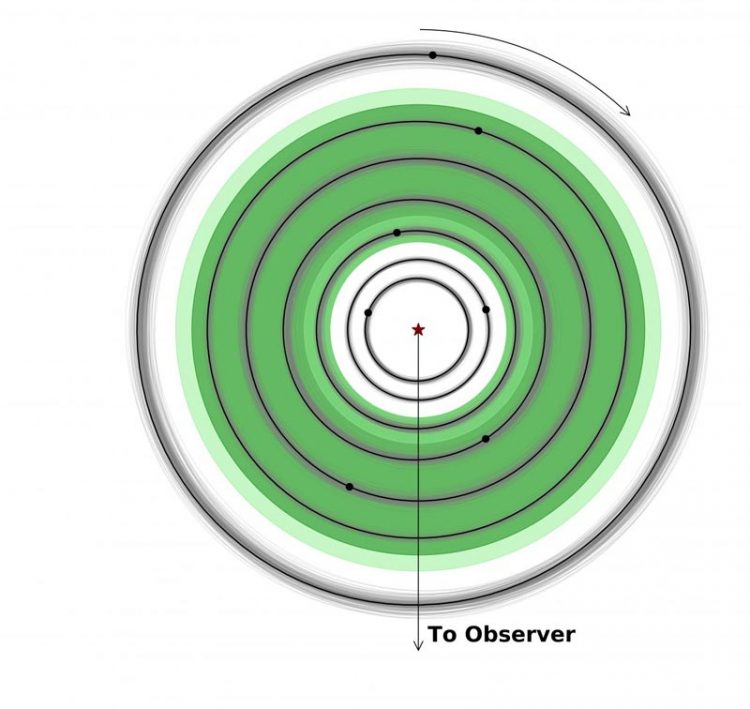OU astrophysicist identifies composition of Earth-size planets in TRAPPIST-1 system

The lighter green indicates optimistic regions of the habitable zone and the darker green denotes more conservative limits. Credit: University of Oklahoma
“The goal of exoplanetary astronomy is to find planets that are similar to Earth in composition and potentially habitable,” said Quarles. “For thousands of years, astronomers have sought other worlds capable of sustaining life.”
Quarles, a researcher in the Homer L. Dodge Department of Physics and Astronomy, OU College of Arts and Sciences, collaborated with scientists, E.V. Quintana, E. Lopez, J.E. Schlieder and T. Barclay at NASA Goddard Space Flight Center on the project.
Numerical simulations for this project were performed using the Pleiades Supercomputer provided by the NASA High-End Computing Program through the Ames Research Center and at the OU Supercomputing Center for Education and Research.
TRAPPIST-1 planets are more tightly spaced than in Kepler systems, which allow for transit timing variations with the photometric observations. These variations tell the researchers about the mass of the planets and the radii are measured through the eclipses.
Mass and radius measurements can then infer the density. By comparing the Earth's density (mostly rock) to the TRAPPIST-1 planets, Quarles can determine what the planets are likely composed of and provide insight into whether they are potentially habitable.
TRAPPIST-1f has the tightest constraints with 25 percent of its mass in water, which is rare given its radius. The concern of this planet is that the mass is 70 percent the mass of the Earth, but it is the same size as the Earth.
Because the radius is so large, the pressure turns the water to steam, and it is likely too hot for life as we know it. The search for planets with a composition as close to Earth's as possible is key for finding places that we could identify as being habitable. Quarles said he is continually learning about the planets and will investigate them further in his studies.
###
ABOUT TRAPPIST-1
TRAPPIST-1 is a nearby ultra-cool dwarf about 40 light-years away from Earth and host to a remarkable planetary system consisting of seven transiting planets. The seven planets are known as TRAPPIST 1b, c, d, e, f, g and h. For more information about TRAPPIST-1, visit https:/
“Plausible Compositions of the Seven TRAPPIST-1 Planets Using Long-term Dynamical Simulations,” was published in the Astrophysical Journal Letters. Funding for this project was provided by NASA Goddard Space Flight Center and University of Oklahoma. For more information, contact Quarles at bquarles@ou.edu.
Figure 1: Simulated orbits of the TRAPPIST-1 planets, where the lighter green indicates optimistic regions of the habitable zone and the darker green denotes more conservative limits.
Media Contact
All latest news from the category: Physics and Astronomy
This area deals with the fundamental laws and building blocks of nature and how they interact, the properties and the behavior of matter, and research into space and time and their structures.
innovations-report provides in-depth reports and articles on subjects such as astrophysics, laser technologies, nuclear, quantum, particle and solid-state physics, nanotechnologies, planetary research and findings (Mars, Venus) and developments related to the Hubble Telescope.
Newest articles

First-of-its-kind study uses remote sensing to monitor plastic debris in rivers and lakes
Remote sensing creates a cost-effective solution to monitoring plastic pollution. A first-of-its-kind study from researchers at the University of Minnesota Twin Cities shows how remote sensing can help monitor and…

Laser-based artificial neuron mimics nerve cell functions at lightning speed
With a processing speed a billion times faster than nature, chip-based laser neuron could help advance AI tasks such as pattern recognition and sequence prediction. Researchers have developed a laser-based…

Optimising the processing of plastic waste
Just one look in the yellow bin reveals a colourful jumble of different types of plastic. However, the purer and more uniform plastic waste is, the easier it is to…


